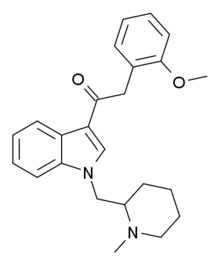From Wikipedia, the free encyclopedia
Chemical compound
Cannabipiperidiethanone Legal status
2-(2-Methoxyphenyl)-1-[1-([1-methylpiperidin-2-yl]methyl)indol-3-yl]ethanone
CAS Number ChemSpider UNII CompTox Dashboard (EPA ) Formula C 24 H 28 N 2 O 2 Molar mass −1 3D model (JSmol )
COc2ccccc2CC(=O)c(c4c1cccc4)cn1CC3CCCCN3C
InChI=1S/C24H28N2O2/c1-25-14-8-7-10-19(25)16-26-17-21(20-11-4-5-12-22(20)26)23(27)15-18-9-3-6-13-24(18)28-2/h3-6,9,11-13,17,19H,7-8,10,14-16H2,1-2H3
Key:AJSBNWAHEDVQJT-UHFFFAOYSA-N
Cannabipiperidiethanone (CPE or 1-(N-methylpiperidin-2-ylmethyl)-3-(2-methoxyphenylacetyl)indole ) is a synthetic cannabinoid that has been found as an ingredient of "herbal" synthetic cannabis blends sold in Japan , alongside JWH-122 and JWH-081 .
Its binding affinity was measured at the CB1 and CB2 receptors and it was found to have an IC50 of 591 nM at CB1 and 968 nM at CB2 , making it 2.3 times and 9.4 times weaker than JWH-250 at these two targets respectively.[ 1]
In the United States , CB1 receptor agonists of the 3-phenylacetylindole class such as cannabipiperidiethanone are Schedule I Controlled Substances .[ 2]
Phytocannabinoids comparison )
Cannabibutols Cannabichromenes Cannabicyclols Cannabidiols Cannabielsoins Cannabigerols Cannabiphorols Cannabinols Cannabitriols Cannabivarins Delta-8-tetrahydrocannabinols Delta-9-tetrahydrocannabinols Delta-10-Tetrahydrocannabinols Miscellaneous cannabinoids Active metabolites
Endocannabinoids Synthetic
Classical cannabinoids Non-classical Adamantoylindoles Benzimidazoles Benzoylindoles Cyclohexylphenols Eicosanoids Indazole-3- Indole-3-carboxamides Indole-3-carboxylates Naphthoylindazoles Naphthoylindoles Naphthoylpyrroles Naphthylmethylindenes Naphthylmethylindoles Phenylacetylindoles Pyrazolecarboxamides Tetramethylcyclo- Tetramethylcyclo- Others
Allosteric CBR Tooltip Cannabinoid receptor ligands Endocannabinoid (inactivation inhibitors) Anticannabinoids (antagonists/inverse
Receptor (ligands )
CB1 Tooltip Cannabinoid receptor type 1
Agonists(abridged,full list ) Inverse agonists Antagonists
CB2 Tooltip Cannabinoid receptor type 2
Agonists
2-AG 2-AGE (noladin ether) 3,3'-Diindolylmethane 4-O-Methylhonokiol α-Amyrin · β-Amyrin A-796,260 A-834,735 A-836,339 AM-1172 AM-1221 AM-1235 AM-1241 AM-2232 Anandamide AZ-11713908 Cannabinol Caryophyllene CB-13 CBS-0550 CP 55,940 GW-405,833 (L-768,242) GW-842,166X HU-308 JTE 7-31 JWH-007 JWH-015 JWH-018 JWH-73 JWH-133 L-759,633 L-759,656 Lenabasum (anabasum) Magnolol MDA-19 Nabitan NADA Olorinab (APD-371) PF-03550096 S-444,823 SER-601 Serinolamide A UR-144 Tedalinab THC (dronabinol) THCV Tetrahydromagnolol Virodhamine Antagonists
NAGly GPR18 )
GPR55
GPR119
Transporter (modulators )
eCBTs Tooltip Endocannabinoid transporter
Enzyme (modulators )
Others
Others: 2-PG (directly potentiates activity of 2-AG at CB1 receptor) ARN-272 (FAAH-like anandamide transporter inhibitor)

